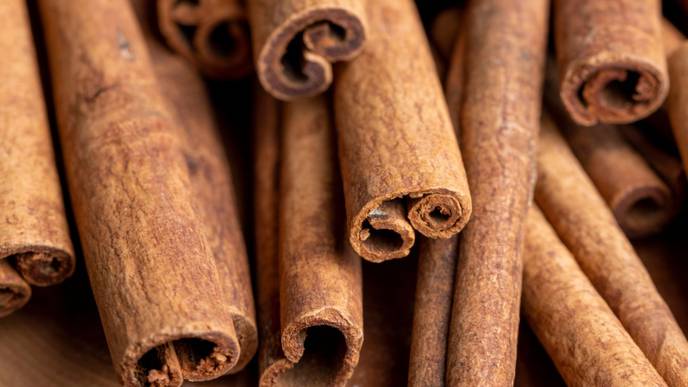Cinnamon for Rheumatoid Arthritis: Benefits and Precautions

01/02/2024
How much cinnamon is in your daily diet? If you have rheumatoid arthritis (RA), sprinkling some of the spice on your morning oatmeal might help you feel better.
One of the most popular kitchen spices today, cinnamon has been used for its anti-inflammatory properties for centuries. “Its use in traditional Chinese medicine and Ayurvedic medicine dates back thousands of years,” says Neha Shah, MD, a rheumatologist and integrative medicine physician at Stanford Health in California.
As is the case with many complementary therapies, there aren’t many “gold standard” clinical trials (randomized, placebo-controlled studies) that look at cinnamon’s impact on rheumatoid arthritis.
“More research is needed to strengthen recommendations on its use. That being said, there is promising recent evidence that cinnamon may be an easy and inexpensive way to reduce inflammation and some symptoms of RA,” Dr. Shah says.
Studies Show Cinnamon Reduces Inflammation and RA Symptoms
The strongest clinical trial evidence for cinnamon impact on RA is a small but well-designed study from researchers in Iran, she says.
“A total of 36 women were randomly placed into one of two groups and received either 2,000 milligrams of cinnamon (four 500 mg capsules) daily or placebo for eight weeks,” says Shah.
At the end of the study, compared to the placebo group, the women who took cinnamon supplements had a decrease in serum levels of both C-reactive protein (CRP), which is produced by the body in response to inflammation, and tumor necrosis factor alpha (TNF-a), a pro-inflammatory protein that plays a central role in many inflammatory conditions, including RA.
TNF-a is part of the inflammatory process that leads to cartilage and bone destruction and joint erosion in RA. Medications such as adalimumab (Humira) and etanercept (Enbrel) target TNF-a, says Shah.
In addition to lowering those signs of systemic inflammation, cinnamon was also associated with clinical signs of improvement, says Shah. “The cinnamon group reported lower levels of pain, and they had lower tender and swollen joint counts as well.”
The spice’s impact on RA inflammatory markers was also found in a meta-analysis that included 12 cinnamon studies, with daily doses ranging from 1.5 to 4 grams (g) per day.
Cinnamon was associated with a significant reduction in C-reactive protein (CRP) and malondialdehyde (MDA), a marker for oxidative stress in RA. The spice was also linked to a marginally statistically significant decrease in interleukin-6, which is produced at inflammation sites.
Overall, the findings suggest that cinnamon supplements may be a potential add-on therapy for reducing inflammation and oxidative stress levels, wrote the authors.
“Studies in animal models and cell culture studies have proven that certain components of cinnamon, specifically one organic compound known as cinnamaldehyde, can reduce levels of certain pro-inflammatory cytokines that are known to contribute to inflammatory arthritis conditions such as RA,” says Shah.
More Research Needed on Complementary Therapies
There’s a growing interest in rheumatology for complementary therapies, says Shah. “Patients are looking for evidence-based methods for controlling inflammation and disease symptoms that have fewer side effects,” she says.
More prospective, double-blind, placebo-controlled studies are needed to further explore cinnamon’s benefits and any potential risks, as well as other complementary RA therapies, says Shah. “This could help us better understand things like how it works, any potential safety concerns, and the ideal dose.”
How to Add Cinnamon to Your Diet: Spice or Supplement?
Given the long-standing safety of cinnamon in culinary uses and the relatively low dose that was found to be efficacious in the Iranian study (2,000 mg would be about two-thirds of a teaspoon), cinnamon is low-hanging fruit for RA patients to add to their daily regimen, says Shah.
Christine Gerbstadt, MD, an anesthesiologist who is also a registered dietitian, advocates for buying ground cinnamon at the grocery store or grinding your own from cinnamon bark and adding it to your food.
“Why would anyone take cinnamon supplements and not just eat the ground bark as a spice? The 2 grams per day in the study group is less than what I sprinkle on my toast, into my tea or yogurt, or add to sauces such as curry and others,” Dr. Gerbstadt says.
She also notes that “supplements are regulated far less stringently than medications and even food in some instances.” She adds, “My concern is in the quality of the supplement and also the effect of the supplement depositing a potentially concentrated supply to the intestinal lining. Eating the ground spice spreads the particles with other food items, which may be better tolerated in the GI tract.”
However you take it, “cinnamon should be used as an adjunct therapy, not in place of prescribed medications for RA,” says Shah.
Cinnamon Supplement Precautions
If you do decide to take cinnamon supplements, check with your physician first.
The National Center for Complementary and Integrative Health notes that cassia cinnamon contains a chemical called coumarin, which can negatively affect your liver if taken over a prolonged period, especially if you already have liver disease.
People who take blood thinners such as warfarin (Coumadin) should also discuss any plans to increase their cinnamon consumption with their doctor because of the possibility of spice-drug interactions.
Whatever You Do, Don’t Take the Cinnamon Challenge
You may have seen videos on social media of young people trying the cinnamon challenge, which involves eating a heaping dry spoonful of the ground spice. You may have also noticed that it never ends well.
According to a perspective piece in the journalPediatrics, attempting to swallow large quantities of dry cinnamon poses real risks of aspiration (inhaling cinnamon into the airways), allergic reactions, pulmonary inflammation, and in severe cases, pulmonary pneumonia.
Although the trend began over a decade ago, there are still stray reports of TikTokers taking the challenge — but be aware, consuming the spice like this could cause serious health issues.

Facebook Comments